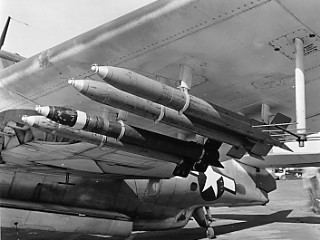Type Air-to-surface rocket Used by United States military Weight 134 pounds (61 kg) | Place of origin United States Produced 1944-1955 Length 68 inches (173 cm) | |
 | ||
The High Velocity Aircraft Rocket, or HVAR, also known by the nickname Holy Moses, was an American unguided rocket developed during World War II to attack targets on the ground from aircraft. It saw extensive use during both World War II and the Korean War.
Contents
Design and development
The HVAR was designed by engineers at Caltech during World War II as an improvement on the 5-Inch Forward Firing Aircraft Rocket (FFAR), which had a 5 inches (13 cm) diameter warhead but an underpowered 3.25 inches (8.3 cm) diameter rocket motor. The desire for improved accuracy from the flatter trajectory of a faster rocket spurred the rapid development. HVAR had a constant 5" diameter for both warhead and rocket motor, increasing propellant from 8.5 to 23.9 pounds (3.9 to 10.8 kg) of Ballistite. U.S. Ballistite propellant had a sea level specific impulse of over 200 seconds, compared with about 180 seconds for the British Cordite, German WASAG and Soviet PTP propellants. Hercules Powder Company was the principal U.S. supplier of high performance extruded Ballistite propellants: 51.5% nitrocellulose, 43% nitroglycerine, 3.25% diethyl phthalate, 1.25% potassium sulphate, 1% ethyl centralite, and 0.2% carbon black. The propellant in U.S. 3.25" and 5" rocket motors consisted of a single large X-shaped cross-section, "cruciform" Ballistite grain cavity. This went against the common practice of filling rocket motors with different numbers of smaller same-sized tubular charges with a round cavity, the number depending on motor diameter. The central hole in a tubular charge makes it more difficult to extrude, requiring a softer propellant blend that also yields somewhat lower performance. Rocket ∆V increased from 216 m/s for the 5" AR to 420 m/s (1,400 ft/s) for HVAR, giving the coveted flat trajectory. This was still somewhat slower than the German R4M World War II rocket's launch velocity of some 525 m/s (1,720 ft/s), with a smaller calibre (55 mm (2.2 in)) and resultant 520 g (1.15 lb) weight of RDX explosive in the R4M ordnance.
Operational service
Two different versions of the HVAR were built during World War II. The warheads were either 1) Mk 4 general purpose warheads with 7.5 pounds (3.4 kg) of TNT and both nose and base fuses or 2) Mk 25 shaped-charge semi-armor-piercing warheads (having an internal copper cone) with 7.5 pounds (3.4 kg) of Composition B and a base fuse only. HVAR testing was complete by D-Day, 6 June 1944, and air-lifted Navy HVAR rockets were soon being loaded on Ninth Air Force Republic P-47D Thunderbolts to support the break-out at Normandy. Other single-engine delivery aircraft included the Vought F4U Corsair, Grumman F6F Hellcat, Grumman TBF/TBM Avenger, and Curtiss SB2C Helldiver. Twin-engine aircraft sometimes armed with HVARs included the Lockheed P-38 Lightning, North American PBJ Mitchell bomber and the Lockheed PV-2 Harpoon bomber. HVAR could penetrate 4 ft of reinforced concrete and was used to sink transports, knock out pillboxes and AA gun emplacements, blow up ammo and oil-storage dumps, and destroy tanks, locomotives, and bunkers. Navy F4U Corsairs and TBF/TBM Avengers made the most extensive use of the rockets in the Pacific theater after the victory in Europe. Over a million HVARs were made during World War II, and production continued until 1955. HVARs remained in the Navy's inventory until the mid-1960s. After World War II, newer versions included a new general purpose type with a proximity fuse, and a new shaped-charge warhead for use against tanks.
HVAR was an effective weapon in the hands of skilled, experienced pilots. It was less effective in the hands of average or inexperienced pilots who were accustomed to taking less careful aim and then "walking in" their gunfire to finally engage a target. HVARs could be fired in pairs or a single rapid-fire salvo but required accurate initial alignment and careful attention to range, or at least a good instinctive sense for the range to the target. HVARs were widely used in the Korean War. Douglas AD-1 Skyraiders often carried a dozen HVARs, and sometimes an additional pair of much larger but less accurate Tiny Tim 11.75-inch (29.8 cm) rockets. Targets included ships, bunkers, pillboxes, coastal defense guns, ammunition dumps, and occasionally even destroyers and major bridges. Numerous North American F-51D Mustang "Six-Shooters" (six .50 cal machine guns plus six HVARs) and carrier-based Grumman F9F Panther jets flew close air support in Korea. Panthers carried 6 HVARs and four 20mm cannons, while both planes could carry an additional pair of 500 lb bombs, napalm, or fuel tanks. Neil Armstrong and John Glenn were among the Panther pilots. It was in Korea that HVARs and Tiny Tims bridged the gap between prop planes and jets: Lockheed F-80C Shooting Star, Republic F-84E Thunderjet, F9F Panther, and North American F-86 Sabre. Jets gave the fighter pilots improved forward visibility. F-84E Thunderjets proved to be the most capable load-lifting fighter/bombers in Korea, demonstrating an ability to loft up to 24 HVARs and 2 Tiny Tims with a combined rocket weight of 5,800 pounds (2,600 kg).
In April 1945, HVAR rockets were used in Operation Bumblebee in the Navy's facility on Island Beach, New Jersey. The HVAR rockets launched 6-inch ramjet engines from wooden frames, accelerating the carbon disulfide fuel ramjets to flight speed. On June 13, the ramjets achieved supersonic speed.
